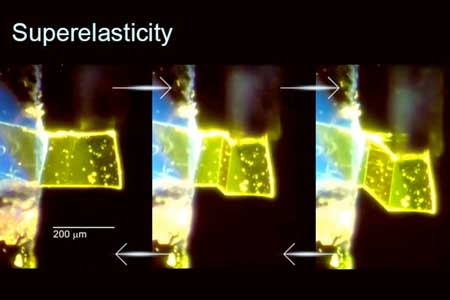| May 01, 2020 | |
Red light for stress(Nanowerk News) Researchers at the Institute of Industrial Science, part of The University of Tokyo, and Yokohama City University have introduced novel color-changing organic crystals that spontaneously return to their original shape and hue after being stressed, a property they call superelastochromism (Nature Communications, "A superelastochromic crystal"). |
|
| These materials can be used to make sensors for shear forces to monitor locations susceptible to damage. | |
 |
|
| Researchers at The University of Tokyo and Yokohama City University create elastic fluorescent crystals that reversibly change color when bent or deformed. This work may lead to the development of durable mechanical sensors that require little or no external power. (Image: Institute of Industrial Science, The University of Tokyo) | |
| The ability to visualize forces can be very useful in many industries, particularly heavy manufacturing and shipping. For example, a color-changing material that shows where beams are being stressed would be great for construction companies. | |
| However, such devices often work once and have to be replaced after being stretched. Materials that bounce back after being stretched or squeezed, like a rubber ball, are called elastic. But even these objects can suffer a permanent change of shape when stressed too much, in a process called plastic deformation. | |
| Now, a team has introduced a new organic material that changes the color of its emitted fluorescence from green to red under mechanical stress, and bounces right back to its original configuration when this stress is removed. | |
| "We called this property 'superelastochromism' because the color changes are due to completely reversible--that is, elastic--changes to the arrangements of molecules in the material," says first author Toshiki Mutai. | |
| Based on 7-chloro-2-(2'-hydroxyphenyl)imidazo[1,2-a]pyridine (7Cl), the crystals consist of molecules that can exist in two distinct configurations. In both states, a hydrogen atom is covalently bonded to an oxygen atom, and only weakly attracted to a nearby nitrogen atom. | |
| When the material is squeezed or bent, the molecular arrangement switches to the other configuration. This mechanically controlled phase transition alters the wavelengths of light the molecule will emit as fluorescence when excited by an external UV light source. The change is clearly apparent to the unaided eye as a shift in color from neon green to reddish orange. | |
| "Chromatic changes in sensors are highly desirable, because they are easily seen and interpreted by people," says senior author Satoshi Takamizawa. "If more precise measurements are needed, spectroscopy can be used to quantify the amount of stress." | |
| This work can help led to a wide range of "smart" material sensors. For example, one could be used to determine the time when mechanical stress is applied or removed. |
| Source: Institute of Industrial Science, The University of Tokyo | |
|
Subscribe to a free copy of one of our daily Nanowerk Newsletter Email Digests with a compilation of all of the day's news. |
